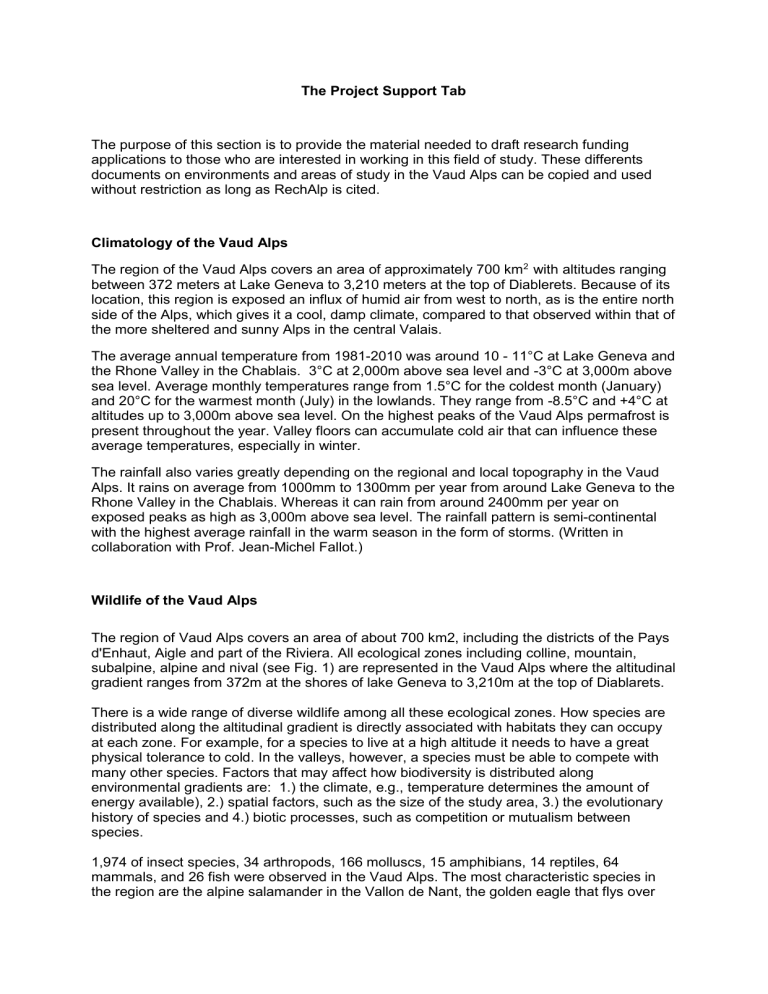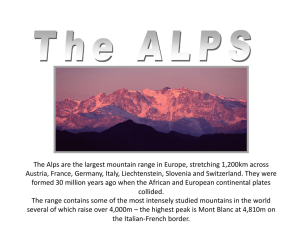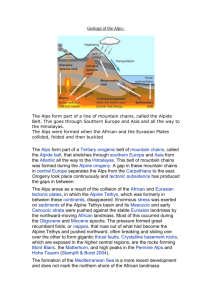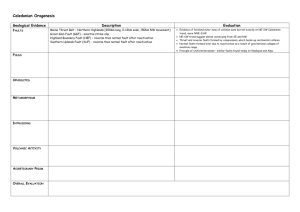Word version

The Project Support Tab
The purpose of this section is to provide the material needed to draft research funding applications to those who are interested in working in this field of study. These differents documents on environments and areas of study in the Vaud Alps can be copied and used without restriction as long as RechAlp is cited.
Climatology of the Vaud Alps
The region of the Vaud Alps covers an area of approximately 700 km 2 with altitudes ranging between 372 meters at Lake Geneva to 3,210 meters at the top of Diablerets. Because of its location, this region is exposed an influx of humid air from west to north, as is the entire north side of the Alps, which gives it a cool, damp climate, compared to that observed within that of the more sheltered and sunny Alps in the central Valais.
The average annual temperature from 1981-2010 was around 10 - 11°C at Lake Geneva and the Rhone Valley in the Chablais. 3°C at 2,000m above sea level and -3°C at 3,000m above sea level. Average monthly temperatures range from 1.5°C for the coldest month (January) and 20°C for the warmest month (July) in the lowlands. They range from -8.5°C and +4°C at altitudes up to 3,000m above sea level. On the highest peaks of the Vaud Alps permafrost is present throughout the year. Valley floors can accumulate cold air that can influence these average temperatures, especially in winter.
The rainfall also varies greatly depending on the regional and local topography in the Vaud
Alps. It rains on average from 1000mm to 1300mm per year from around Lake Geneva to the
Rhone Valley in the Chablais. Whereas it can rain from around 2400mm per year on exposed peaks as high as 3,000m above sea level. The rainfall pattern is semi-continental with the highest average rainfall in the warm season in the form of storms. (Written in collaboration with Prof. Jean-Michel Fallot.)
Wildlife of the Vaud Alps
The region of Vaud Alps covers an area of about 700 km2, including the districts of the Pays d'Enhaut, Aigle and part of the Riviera. All ecological zones including colline, mountain, subalpine, alpine and nival (see Fig. 1) are represented in the Vaud Alps where the altitudinal gradient ranges from 372m at the shores of lake Geneva to 3,210m at the top of Diablarets.
There is a wide range of diverse wildlife among all these ecological zones. How species are distributed along the altitudinal gradient is directly associated with habitats they can occupy at each zone. For example, for a species to live at a high altitude it needs to have a great physical tolerance to cold. In the valleys, however, a species must be able to compete with many other species. Factors that may affect how biodiversity is distributed along environmental gradients are: 1.) the climate, e.g., temperature determines the amount of energy available), 2.) spatial factors, such as the size of the study area, 3.) the evolutionary history of species and 4.) biotic processes, such as competition or mutualism between species.
1,974 of insect species, 34 arthropods, 166 molluscs, 15 amphibians, 14 reptiles, 64 mammals, and 26 fish were observed in the Vaud Alps. The most characteristic species in the region are the alpine salamander in the Vallon de Nant, the golden eagle that flys over
the highest of peaks, the lynx, the common adder/viper, or the old world wallowtail and the
Apollo (butterfly). (Source: Swiss Centre for Wildlife Mapping)
In 2014, 153 species of birds were observed in the Vaud Alps (of which 142 were nesting).
Some of the most common species found in coniferous forests are the dunnock, the coal tit, crested tit, goldcrest, the song thrush, the mistle thrush, the ring ouzel and the citril finch.
Other species typical of mountainous regions are: the black grouse, rock partridge, threetoed woodpeckers and the grey wagtail. Birds in the Hautes-Alpes, such as the water pipit, alpine accenteur, the alpine chough and the white-winged snow finch, are also breeding species of this area. The region of Grangettes, which is of great ornithological importance, is the most important nesting wetland of Lake Geneva. The great crested grebe, black kite and the green woodpecker are among 68 species that nest there. This area is an important nesting site for the golden oriole, the common nightingale and reed warblers. (Source:
Vogelwarte & Birdlife) (Written in collaboration with Jean-Nicolas Pradervand)
Geology of the Vaud Alps
Several large tectonic units are present in the Vaud Alps. In the Vevey-Montreaux Riviera we find the Subalpine Molasse. Further southwest, two large formations make up the rest of the
Vaud Alps, the Prealp nappes and the Helvetic nappes. These large formations can each be subdivided into several nappes. For the Prealps there are: the plastic and rigid Median
Prealp nappes, the Niesen nappes, and the Simme, Brèche, and Gurnigel nappes, the
Submedian Zone, as well as a part of the Ultrahelvitic nappes. The Morcles, Diablarets,
Windhorn (Mt. Gond and Sublage) nappes, as well as the Ultrahelvitic nappes, themselves, connect to the helvetic formations. The area is also covered with Quaternary deposits, among others in the Rhone valley where alluvial deposits can be particulary thick. (Written in collaboration with Professor Jean-Luc Epard.)
Taken from the section of the Alps, modified from Escher et al. 1994.
Geomorphology of the Vaud Alps
The geomorphology of the Vaud Alps is strongly linked to the local geology, with a very rich diversity, and is linked to the diversity of the types of rocks and tectonic styles of the different nappes. In the Prealps, the slopes are often steep and vegetated. Where there are massive limestone deposits, the rock walls are often well developed. In these sectors, cones and scree structures are abundant. Numerous landslides affect the slopes of flysch deposits (ie.
The Frasse) and moraine slopes. Alpine nappes, such as the Helvetic, develop very high slopes alternating between rock walls and ledges.
The humidity of the climate of the Vaud Alps maintains a relatively low snow line, which explains the presence of many small glaciers in the northern slopes of the Dent de Morcles-
Grand Muveran-Diablerets mountain range. The withdrawal of these glaciers since the end of the Little Ice Age has exposed large proglacial fields demarcated by well-preserved moraines such as the Martinets glaciers and the Plan Névé. Past extensions of these glaciers involve vast tracts of Würm and Tardiglacaire moraine cover, as well as many tracks of Tardiglacaire moraine particularly well-preserved in the massive Prealps, such as the high Veveyse,
Hongrin, Col des Mosses, the valleys of the Etivaz, and Forclaz.
Active periglacial forms like rock glaciers, are limited due to moderate altitudes and the presence of glaciers at relatively low altitudes. However, the region has several large fossil rock glaciers, such as in the north-west face of Mont d'Or or around the Gummfluh.
Torrential rainfall is very common where slopes are steep and there is significant sediment load. The valleys of Etivaz, the south side of the Diablerets (Anzeindaz) and the Nant valley are the areas where this phenomenon is most common. Large alluvial fans can be observed.
Moreover, the forms of fluvial accumulation are generally restricted because the valleys are often very steep.
Karst forms are particularly well developed around the Tour de Famelon, with the presence of a vast expanse of lapiés. Special karsts are observed in the gypsum Zone of Passes (the passes of la Croix, of Pillon, and of Krinnenpass) and the Submedian Zone ( La Lécherette).
(Written in collaboration with Dr. Christophe Lambiel & Prof. Philippe Schoeneich)
Hydrology of the Vaud Alps
The hydrology of the Vaud Alps is determined by: (1) their position within Europe, which means that there are strong Atlantic influences upon the climate; (2) their altitudinal range, which means that a significant proportion of winter precipitation can fall as snow; and (3) their location on the north-west side of the main Swiss Alpine mountain chain, which can lead to strong orographic forcing of precipitation. Because a significant proportion of winter precipitation may fall as snow, river basin runoff is characteristically nival-pluvial. The balance between winter snow storage with summer release and direct runoff depends primarily upon the altitudinal range of the river basin which determines what percentage of rainfall falls as snow as well as how long the snow cover remains. This balance is not simply controlled by winter precipitation totals but also temperature, through its effect on the snow stock of each river basin. But, characteristically, the hydrological response can be summarized as: (1) for lower altitude basins (< c. 800 m), runoff generally follows precipitation, although there may be occasional and temporary storage of precipitation as snow; (2) for mid altitude basins (c. 800 m to c. 1,500m), there is commonly some winter snow storage, with snow melt occurring in the early Spring; and (3) for higher altitude basins, substantial snow storage may occur, with the peak snowmelt and hence runoff occurring in the late spring. Note that these altitudes are indicative and that they will vary from year to year with prevailing ca tchment conditions. They will also vary with the basin’s aspect.
Accumulated snow may be sufficient to maintain higher levels of base flow through the summer in some catchments. Otherwise, summer river flows tend to be very low, but impacted upon by occasional convective storm events. The highest basins may have very
small glaciers (typically much less than 5% of the basin area) which may also maintain summer low flows. Groundwater contributions can also be important in sustaining base flows.
There is a strong human impact upon the hydrology of most of the region. Many of the basins are exploited for hydroelectric purposes, although this is much less concerned with dams and more associated with water transfers. Water is extracted, transferred at altitude through tunnels, and then returned either to the same river or the river in an adjacent valley through relatively small-scale hydroelectric power plants. Although there is relatively little in the way of water storage, this kind of abstraction can change substantially the volume of water within individual river channels as well lead to sediment management problems. (Written in collaboration with Professor Stuart Lane.)
Soil of the Vaud Alps
The bedrock of the Vaud Alp region is mainly limestone, but shale, granite, and dolomite can also be found. Different soil types are present, from deep brown soils, called Brunisols, to brown leached soils called Neoluvisols. Fine soils resting directly on the substrate (lithosol) are also observable. These last ones have a greater influence on the vegetation.
Alkaline soil formation is promoted by the presence of cation and carbonates. However, the latter can be followed by a Pedogenesis acid following the leaching of carbonates. The postglacial loess accumulation in this region accelerates the transition to an acidic soil formation.
(Written in collaboration with Dr. Carmen Cianfrani & Aline Buri.)
Vegetation and ecological environments of the Vaud Alps
The region of Vaud Alps covers an area of about 700 km 2 , including the districts of the Pays d'Enhaut, Aigle and part of the Riviera. All ecological zones including colline, mountain, subalpine, alpine and nival (see Fig. 1) are represented in the Vaud Alps where the altitudinal gradient ranges from 372m at the shores of lake Geneva and 3,210m at the top of
Diablarets. The eight main groups of Swiss environments according to Delarze & Gonseth
(2008) are present in the Vaud Alps; these are: 1.) open waters, 2.) shores and wetlands, 3.) glaciers, exposed rock, scree and moraines, 4.) lawns and meadows, 5.) moors, forest edges and tall-herbs, 6.) forests, 7.) newgrowth vegetation in places disturbed by Man, and 8.) plantations, fields and crops.
In lower altitudes deciduous forests, mainly beech and some oaks in the hotter regions, are found alongside manmade environments like vineyards, meadows, farmland, and buildings.
Forests in the middle altitudes are composed naturally of beech and fir, even if forest workers try to promote spruces. Here, the farm is still important with many meadows and pastures.
Further up, the spruce forests dominate usually forming the boundary of the forest. There, larch and stone pine are also present. Rhododendron moorlands are common in seldom grazed areas around the boundary of the forest, and green alder bushes colonize abandoned pastures. Higher above that, the alpine zone mainly occupied by alpine meadows interspersed with wide scree and exposed rocky surfaces. (Written in collaboration with Dr.
Pascal Vittoz.)





![Real-Life Climate Change Stories [WORD 512KB]](http://s3.studylib.net/store/data/006775264_1-25b312f26ec237da66580d55aa639ecf-300x300.png)

